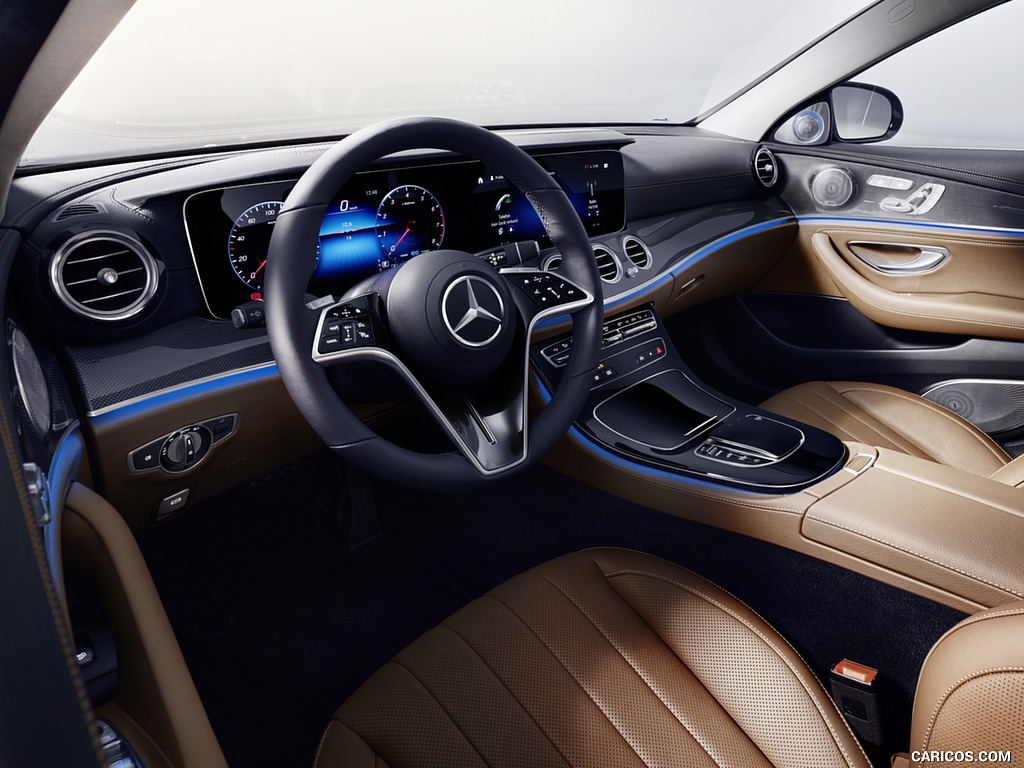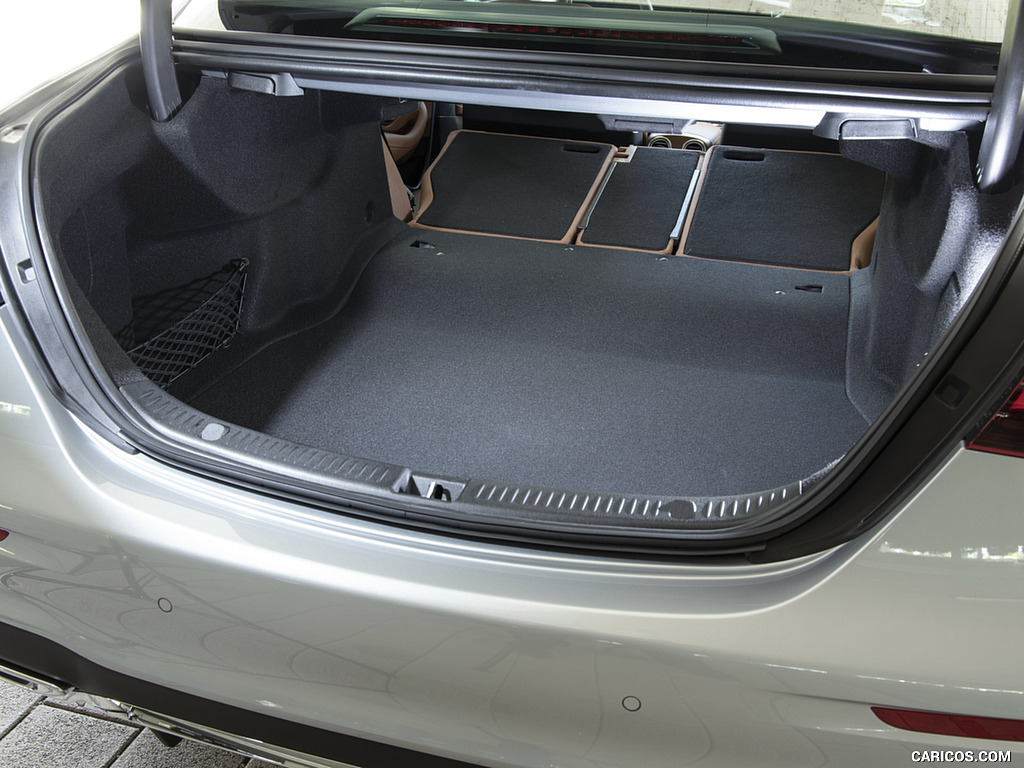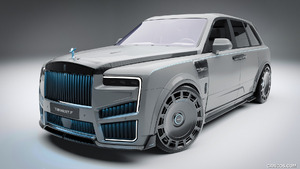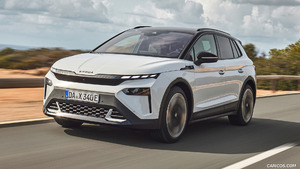2021 E-Class
Exciting and dynamic automotive intelligence: the E-Class Sedan and Wagon are the first representatives of the thoroughly updated model series. The E-Class Sedan, and for the first time the new All- Terrain, will go on sale in the U.S. in the fall of 2020.
With over 14 million Sedan and Wagon models delivered globally since 1946, the E-Class is the best-selling model series in the history of Mercedes-Benz and is perceived by many as the "heart of the brand". The tenth generation of the E- Class set styling trends in 2016 with its clean yet emotionally appealing design and exclusive high-quality interior. A wealth of innovations, such as the driving assistance systems, were also defining characteristics. This emotionally appealing and at the same time intelligent combination has proven extremely successful: to date, more than 1.2 million customers around the world have bought a current-generation E-Class Sedan or E-Class Wagon.
Here the key facts about the refresh:
- More dynamic design
- Redesigned front headlamps (full-LED headlamps as standard, optionally available MULTIBEAM LED headlamps)
- Redesigned taillamps
- Redesigned radiator grille and front bumper
- All-Terrain variant visually more similar to the SUV models
- Next-generation driving assistance systems, including:
- New steering wheel generation with capacitive hands-off detection
- Active Distance Assist DISTRONIC with route-based speed adjustment
- Active Stop-and-Go Assist
- Active Steering Assist
- Active Brake Assist; in the Driving Assistance Package now also with turning maneuver function
- Active Blind Spot Assist – now also with exit warning
- Parking Package in conjunction with 360° camera: newly expanded side view
- Even more comfort in the interior
- Standard widescreen cockpit with two 12.3-inch displays
- MBUX with LINGUATRONIC voice control (standard) and augmented video for navigation (available)
- Interior Assistant (available)
- E as in efficiency: electrification of the powertrain
- Electrified models for the first time in the U.S. market
- M256 engine available for 450 models: 3.0L, inline 6-cylinder gasoline engine with ISG and 48-volt onboard electrical system, rated output: 362 hp, NANOSLIDE® coated cylinder barrels, CAMTRONIC for controlling the intake valves.
More dynamic design
The enhanced dynamic design is reflected throughout both the exterior and interior. The new front end with revised grille plays a key role in the fresh appearance. The new grille features a single louvre and chrome pins. Chrome and high-gloss black trim elements on the front bumper underscore the sporty and elegant appearance.
 2021 Mercedes-Benz E-Class
2021 Mercedes-Benz E-Class
The E-Class features standard AMG body cladding for the sedan. Additionally, both the Sedan and All-Terrain feature power domes on the hood to underscore the sporty design along with all-LED headlamps as standard.
The designers also updated the Sedan's rear end with a new bumper, split taillamps and a new trunk lid. The taillamps have been revised to feature a new, geometric design.
The All-Terrain is visually similar to the SUV models, with signature All-Terrain components such as the radiator grille or the stylized skid plate now sporting a mirror chrome finish.
Three new metallic paint colors are available for the E-Class as part of the model refresh including Cirrus Silver, Graphite Grey and Mojave Silver. The wheel line-up has also been expanded and now includes aero wheels, which contribute to fuel savings and thus to sustainability.
New colors and materials upgrade the interior. These include new color combinations Magma Grey/Neva Grey and Magma Grey/Macchiato Beige, and trim in Natural Grain Grey Ash Wood and an updated version of Burl Walnut Wood.
The seats combine the hallmark Mercedes-Benz long-distance suitability with modern design. The adaptive driver's seat adjustment is particularly convenient: When the height of the body is entered on the media display, the seat automatically moves into a height-suggested fitting position, which then only needs to be fine-tuned by the driver.
The design of the front seats accentuates the sporty aura of the interior. They offer strong lateral support without compromising comfort. The seat contour follows the pronounced side bolsters and, depending on the specification, the center section has sporty transverse or modern longitudinal seams. The colors of the center sections of the seat backrest and cushion match the overall sculpture of the seats.
Next-generation driving assistance systems: improved assistance in traffic and when parking
The new E-Class has the latest generation of Mercedes-Benz driving assistance systems providing cooperative support to drivers. This results in an especially high level of active safety: the Sedan and All-Terrain are able to react if the driver doesn't through the hands-off recognition, which now works on a capacitive basis. This enhances user-friendliness when driving in semi-automated mode. In order to inform the assistance systems that the driver still has control of the E- Class, it is sufficient for the driver to hold the steering wheel. Previously, a slight steering movement was required as feedback when utilizing the assistance systems. Now, the new steering wheel features a pad with the appropriate sensors in the rim that register whether the driver is holding the wheel. If the system detects that the driver does not have their hands on the steering wheel for a certain period of time, a warning cascade is initiated, which ultimately activates Emergency Brake Assist if the driver continues to be inactive.
As standard, the E-Class comes with Active Brake Assist, which in many situations is able to use autonomous braking to prevent a collision or mitigate its severity. At normal city speeds, the system is also able to brake for stationary vehicles and crossing pedestrians, and even to prevent collisions depending on the situation. As part of the Driving Assistance Package, this is now also possible when turning off across the oncoming lane.
The updated Driver Assistance package also includes Active Speed Limit Assist, which uses map data and information from Traffic Sign Assist to respond to changes in the speed limit. Route-based speed adjustment ahead of bends, roundabouts, toll stations, three-way stops and prior to turning off or exiting highways, is also included in the scope of delivery. When the driver switches on Active Distance Assist DISTRONIC with route-based speed adjustment, the E- Class is now able to respond to data from LiveTraffic Information. Ideally, this happens even before the driver or the radar and camera sensors are able to detect a traffic obstruction. When a traffic jam is detected, the speed is reduced to approx. 60 mph as a precaution unless the driver deliberately decides otherwise.
When driving in a traffic jam on the highway, Active Stop-and-Go Assist is largely able to perform the tasks of keeping the vehicle within the lane and maintaining a safe distance with a high level of availability at speeds up to around 35 mph. When properly equipped, the vehicle can restart automatically up to one minute after coming to a stop.
Active Blind Spot Assist with exit warning offers enhanced protection when getting out of the car. It is able to respond to vehicles in the blind spot as well as in the critical area with an active brake intervention. When the vehicle is stopped, the system can now also warn the passengers visually in the exterior mirror before they get out if a vehicle, or even a bicycle, is driving past in the critical area. If the driver tries to use the door handle at this moment, an additional audible warning will sound and the ambient door lighting will start to flash red. It detects passing road users moving at a speed of more than 5 mph. The function is also available when the vehicle is stationary and up to three minutes after the ignition has been switched off.
Active Parking Assist with PARKTRONIC and 360° camera makes it possible to enter and leave parking spaces automatically. The system facilitates the search for and selection of a parking space as well as entering and leaving (if the vehicle was parked automatically) parallel and end-on parking spaces or garages. The 360° camera transmits an even more realistic image to the media display, which includes an expanded side view. When leaving a parking space, the system is able to warn of traffic crossing behind the vehicle and can apply the brakes if needed.
Even more comfort in the interior: MBUX
The E-Class is fitted with an entirely new steering wheel as part of the model update. It is available as either an all- leather steering wheel or a wood-leather combination. The control surfaces feature a high-gloss black finish, while the trim elements and surrounds have a silver shadow finish. The instrument cluster and the media display are controlled by swiping along the Touch Control Buttons. The operating principle of the Touch Control Buttons changes from optical to capacitive. A mechanical system was no longer needed, and the touch surfaces also are less susceptible to fingerprints. Whether the driver has control of the steering wheel is now determined by means of capacitive detection (see section on the driving assistance systems).
The new E-Class is equipped with the latest generation of the MBUX multimedia system (Mercedes-Benz User Experience). As standard, it includes two large 12.3 inch screens, which are arranged side by side for a widescreen appearance. The information in the instrument cluster and on the media display is easily legible on the large, high- resolution screens. An emotive presentation with brilliant graphics underlines the comprehensibility of the intuitive control structure.
Depending on mood or to match the particular interior, the user has a choice of four different styles:
- Modern Classic is a further development of the classic display style in an elegant and light material mix.
- Sporthas a high-tech turbine look with decidedly sporty black/yellow contrasts.
- Progressive stages the digital realm in reduced form.
- In the Discreet style, all displays are reduced to the absolutely necessary.
Other highlights include touchscreen control of the media display as standard and the use of the available augmented reality technology for the navigation display when the navigation function is active: A video image of the surroundings is enhanced with helpful navigation information: arrows or house numbers are automatically superimposed directly onto the image in the media display, for example. The system also assists the driver at traffic lights when the necessary infrastructure is in place: If the E-Class is the first car at the lights, the current traffic light situation is superimposed, this new function is a particularly helpful when there is a poor line of sight to the traffic light.
The optional MBUX Interior Assistant allows intuitive, natural operation of various comfort and MBUX functions through movement recognition. For example, when a hand approaches the touchscreen or the touchpad on the center console, the media display changes, and individual elements are highlighted.
E as in efficiency: electrification of the powertrain
The electrification of the powertrain takes another major step forward with the model update of the E-Class. E 450 models will receive the M 256 3.0L inline 6-cylinder turbo engine with EQ Boost technology. Models equipped with this engine will have a 48-volt on-board electrical system. Thanks to energy recovery and the ability to "glide" with the engine switched off, the gas engine is highly efficient.
The heart of the brand: the success story of the E-Class
Already in the early 20th century, vehicles positioned below the top-of-the-range and luxury classes, yet above the compact class, were an essential part of the model portfolio of Mercedes-Benz and the brands that came before. The first Mercedes models, which came to market in 1901 and established the concept of modern automotive construction, were already available in different versions and targeted different customers – including those who would choose a vehicle of the upper mid-range segment today.
With over 14 million units delivered since 1946, the E-Class is the best-selling model series in the history of Mercedes- Benz. It is perceived by many as the "heart of the brand". Customers of the E-Class are among the most loyal fans of the Mercedes star: Eight out of ten E-Class Sedan customers remain loyal to Mercedes-Benz when buying their next vehicle.
When production started up again after the Second World War, the first car to go into production was the 170 V model, originally introduced in 1936, initially as a vehicle for rescue services, police, commerce and trades. It was soon followed by a sedan version as the first post-war Mercedes-Benz passenger car in 1947.
The 180 model (W 120) of 1953 with unibody and "Ponton" shape set new technical as well as formal trends. It was followed in 1961 by the four-cylinder versions of the "Fintail" model series (W 110) – the first model with safety body and crumple zones. The next major step came seven years later in the form of the "Stroke Eight" (model series W 115/114). At the same time, with the arrival of the first coupe model, this marked a widening of the scope of available body variants. Its success was surpassed yet again by the successor model series 123 starting in 1976. It was also produced in a wagon version – with which Mercedes-Benz set standards for the wagon car as a family-friendly lifestyle and recreational vehicle. The 124 series of the years 1984 to 1995, which was also available as a four-seater cabriolet, was first given the name E-Class in mid-1993.
The "four headlamps" face and its innovative technology were the characteristic features of the 210 model series launched in 1995. The E-Class of model series 211 was launched in early 2002. In 2009 it was followed by the 212 series (Sedan and Wagon) and the 207 series (Cabriolet and Coupé), and from 2010 the E-Class Sedan also became available as the V 212 long version produced in and for China. In 2016, Mercedes-Benz launched the E-Class of model series 213. Starting in 2017, the Wagon was also available as an All-Terrain version for the first time.
Modern digital production of the new E-Class
The E-Class Sedan and Wagon are produced in the Mercedes-Benz Sindelfingen Plant and come off the same line as the Mercedes-Benz CLS and the Mercedes-AMG GT 4-door Coupe in a flexible production system. The production uses modern digital technologies – from smartphones for locating vehicles on the line and additive manufacturing methods for producing equipment to digital shop floor management, which involves various key indicators being managed in one system. The production also uses the Ubisense system. This system locates the fastening tools an employee requires in the assembly process and provides the employee with the necessary information about a specific vehicle. In this way, only the tools actually required for working on the vehicle are activated. The employee receives optimal support in the assembly process. The Sindelfingen plant is the center of competence for passenger cars of the upper and luxury segment as well as the lead plant for the S- and E-Class. The location employs more than 35,000 people. In addition to the aforementioned models, Mercedes-Benz produces the S-Class Sedan, Coupe and Cabriolet, Mercedes-Maybach S-Class as well as the Mercedes-AMG GT family there. Going forward, this will also be the location for the production of electric vehicles of the new EQ product and technology brand. Starting in 2022, the Mercedes-Benz Sindelfingen Plant will be fully CO2-neutral. Furthermore, "Factory 56", one of the world's most cutting-edge automobile production facilities, is currently under construction at the location.
---Front-221511-120x90.jpg)
---Front-221511-1024x768.jpg) \n
\n---Front-Three-Quarter-221512-120x90.jpg)
---Front-Three-Quarter-221512-1024x768.jpg) \n
\n---Front-Three-Quarter-221513-120x90.jpg)
---Front-Three-Quarter-221513-1024x768.jpg) \n
\n---Rear-Three-Quarter-221514-120x90.jpg)
---Rear-Three-Quarter-221514-1024x768.jpg) \n
\n---Front-Three-Quarter-221515-120x90.jpg)
---Front-Three-Quarter-221515-1024x768.jpg) \n
\n---Front-Three-Quarter-221516-120x90.jpg)
---Front-Three-Quarter-221516-1024x768.jpg) \n
\n---Rear-Three-Quarter-221517-120x90.jpg)
---Rear-Three-Quarter-221517-1024x768.jpg) \n
\n---Side-221518-120x90.jpg)
---Side-221518-1024x768.jpg) \n
\n---Rear-Three-Quarter-221519-120x90.jpg)
---Rear-Three-Quarter-221519-1024x768.jpg) \n
\n---Rear-Three-Quarter-221520-120x90.jpg)
---Rear-Three-Quarter-221520-1024x768.jpg) \n
\n---Front-221521-120x90.jpg)
---Front-221521-1024x768.jpg) \n
\n---Front-Three-Quarter-221522-120x90.jpg)
---Front-Three-Quarter-221522-1024x768.jpg) \n
\n---Rear-221523-120x90.jpg)
---Rear-221523-1024x768.jpg) \n
\n---Front-Three-Quarter-221524-120x90.jpg)
---Front-Three-Quarter-221524-1024x768.jpg) \n
\n---Side-221525-120x90.jpg)
---Side-221525-1024x768.jpg) \n
\n---Rear-Three-Quarter-221526-120x90.jpg)
---Rear-Three-Quarter-221526-1024x768.jpg) \n
\n---Rear-221527-120x90.jpg)
---Rear-221527-1024x768.jpg) \n
\n---Front-221528-120x90.jpg)
---Front-221528-1024x768.jpg) \n
\n---Front-Three-Quarter-221529-120x90.jpg)
---Front-Three-Quarter-221529-1024x768.jpg) \n
\n---Front-Three-Quarter-221530-120x90.jpg)
---Front-Three-Quarter-221530-1024x768.jpg) \n
\n---Front-Three-Quarter-221531-120x90.jpg)
---Front-Three-Quarter-221531-1024x768.jpg) \n
\n---Front-Three-Quarter-221532-120x90.jpg)
---Front-Three-Quarter-221532-1024x768.jpg) \n
\n---Side-221533-120x90.jpg)
---Side-221533-1024x768.jpg) \n
\n---Side-221534-120x90.jpg)
---Side-221534-1024x768.jpg) \n
\n---Rear-Three-Quarter-221535-120x90.jpg)
---Rear-Three-Quarter-221535-1024x768.jpg) \n
\n---Rear-Three-Quarter-221536-120x90.jpg)
---Rear-Three-Quarter-221536-1024x768.jpg) \n
\n---Headlight-221537-120x90.jpg)
---Headlight-221537-1024x768.jpg) \n
\n---Tail-Light-221538-120x90.jpg)
---Tail-Light-221538-1024x768.jpg) \n
\n
 \n
\n
 \n
\n
 \n
\n---Front-Three-Quarter-221542-120x90.jpg)
---Front-Three-Quarter-221542-1024x768.jpg) \n
\n---Front-Three-Quarter-221543-120x90.jpg)
---Front-Three-Quarter-221543-1024x768.jpg) \n
\n---Side-221544-120x90.jpg)
---Side-221544-1024x768.jpg) \n
\n---Rear-Three-Quarter-221545-120x90.jpg)
---Rear-Three-Quarter-221545-1024x768.jpg) \n
\n---Rear-Three-Quarter-221546-120x90.jpg)
---Rear-Three-Quarter-221546-1024x768.jpg) \n
\n---Interior-221547-120x90.jpg)
---Interior-221547-1024x768.jpg) \n
\n---Rear-221548-120x90.jpg)
---Rear-221548-1024x768.jpg) \n
\n---Front-221549-120x90.jpg)
---Front-221549-1024x768.jpg) \n
\n---Headlight-221550-120x90.jpg)
---Headlight-221550-1024x768.jpg) \n
\n---Tail-Light-221551-120x90.jpg)
---Tail-Light-221551-1024x768.jpg) \n
\n
 \n
\n
 \n
\n
 \n
\n
 \n
\n
 \n
\n
 \n
\n---Front-Three-Quarter-221558-120x90.jpg)
---Front-Three-Quarter-221558-1024x768.jpg) \n
\n---Rear-221559-120x90.jpg)
---Rear-221559-1024x768.jpg) \n
\n---Rear-221560-120x90.jpg)
---Rear-221560-1024x768.jpg) \n
\n---Side-221561-120x90.jpg)
---Side-221561-1024x768.jpg) \n
\n---Front-Three-Quarter-221562-120x90.jpg)
---Front-Three-Quarter-221562-1024x768.jpg) \n
\n---Rear-221563-120x90.jpg)
---Rear-221563-1024x768.jpg) \n
\n---Front-Three-Quarter-221564-120x90.jpg)
---Front-Three-Quarter-221564-1024x768.jpg) \n
\n---Front-Three-Quarter-221565-120x90.jpg)
---Front-Three-Quarter-221565-1024x768.jpg) \n
\n---Side-221566-120x90.jpg)
---Side-221566-1024x768.jpg) \n
\n---Rear-Three-Quarter-221567-120x90.jpg)
---Rear-Three-Quarter-221567-1024x768.jpg) \n
\n---Rear-Three-Quarter-221568-120x90.jpg)
---Rear-Three-Quarter-221568-1024x768.jpg) \n
\n---Rear-221569-120x90.jpg)
---Rear-221569-1024x768.jpg) \n
\n---Front-221570-120x90.jpg)
---Front-221570-1024x768.jpg) \n
\n---Headlight-221571-120x90.jpg)
---Headlight-221571-1024x768.jpg) \n
\n---Wheel-221572-120x90.jpg)
---Wheel-221572-1024x768.jpg) \n
\n---Hood-221573-120x90.jpg)
---Hood-221573-1024x768.jpg) \n
\n---Mirror-221574-120x90.jpg)
---Mirror-221574-1024x768.jpg) \n
\n
 \n
\n
 \n
\n
 \n
\n
 \n
\n
 \n
\n
 \n
\n---Front-Three-Quarter-221581-120x90.jpg)
---Front-Three-Quarter-221581-1024x768.jpg) \n
\n---Rear-Three-Quarter-221582-120x90.jpg)
---Rear-Three-Quarter-221582-1024x768.jpg) \n
\n---Front-Three-Quarter-221583-120x90.jpg)
---Front-Three-Quarter-221583-1024x768.jpg) \n
\n---Rear-Three-Quarter-221584-120x90.jpg)
---Rear-Three-Quarter-221584-1024x768.jpg) \n
\n---Rear-Three-Quarter-221585-120x90.jpg)
---Rear-Three-Quarter-221585-1024x768.jpg) \n
\n---Front-Three-Quarter-221586-120x90.jpg)
---Front-Three-Quarter-221586-1024x768.jpg) \n
\n---Rear-Three-Quarter-221587-120x90.jpg)
---Rear-Three-Quarter-221587-1024x768.jpg) \n
\n---Rear-Three-Quarter-221588-120x90.jpg)
---Rear-Three-Quarter-221588-1024x768.jpg) \n
\n---Front-Three-Quarter-221589-120x90.jpg)
---Front-Three-Quarter-221589-1024x768.jpg) \n
\n---Rear-Three-Quarter-221590-120x90.jpg)
---Rear-Three-Quarter-221590-1024x768.jpg) \n
\n---Rear-Three-Quarter-221591-120x90.jpg)
---Rear-Three-Quarter-221591-1024x768.jpg) \n
\n---Front-Three-Quarter-221592-120x90.jpg)
---Front-Three-Quarter-221592-1024x768.jpg) \n
\n---Front-Three-Quarter-221593-120x90.jpg)
---Front-Three-Quarter-221593-1024x768.jpg) \n
\n---Rear-Three-Quarter-221594-120x90.jpg)
---Rear-Three-Quarter-221594-1024x768.jpg) \n
\n---Rear-221595-120x90.jpg)
---Rear-221595-1024x768.jpg) \n
\n---Front-221596-120x90.jpg)
---Front-221596-1024x768.jpg) \n
\n---Grille-221597-120x90.jpg)
---Grille-221597-1024x768.jpg) \n
\n---Headlight-221598-120x90.jpg)
---Headlight-221598-1024x768.jpg) \n
\n---Headlight-221599-120x90.jpg)
---Headlight-221599-1024x768.jpg) \n
\n---Headlight-221600-120x90.jpg)
---Headlight-221600-1024x768.jpg) \n
\n---Wheel-221601-120x90.jpg)
---Wheel-221601-1024x768.jpg) \n
\n---Tail-Light-221602-120x90.jpg)
---Tail-Light-221602-1024x768.jpg) \n
\n---Tail-Light-221603-120x90.jpg)
---Tail-Light-221603-1024x768.jpg) \n
\n---Engine-221604-120x90.jpg)
---Engine-221604-1024x768.jpg) \n
\n---Engine-221605-120x90.jpg)
---Engine-221605-1024x768.jpg) \n
\n---Interior,-Cockpit-221606-120x90.jpg)
---Interior,-Cockpit-221606-1024x768.jpg) \n
\n---Interior-221607-120x90.jpg)
---Interior-221607-1024x768.jpg) \n
\n---Interior-221608-120x90.jpg)
---Interior-221608-1024x768.jpg) \n
\n---Interior,-Steering-Wheel-221609-120x90.jpg)
---Interior,-Steering-Wheel-221609-1024x768.jpg) \n
\n---Central-Console-221610-120x90.jpg)
---Central-Console-221610-1024x768.jpg) \n
\n---Central-Console-221611-120x90.jpg)
---Central-Console-221611-1024x768.jpg) \n
\n---Interior,-Detail-221612-120x90.jpg)
---Interior,-Detail-221612-1024x768.jpg) \n
\n---Interior,-Detail-221613-120x90.jpg)
---Interior,-Detail-221613-1024x768.jpg) \n
\n---Interior,-Front-Seats-221614-120x90.jpg)
---Interior,-Front-Seats-221614-1024x768.jpg) \n
\n---Interior,-Seats-221615-120x90.jpg)
---Interior,-Seats-221615-1024x768.jpg) \n
\n---Interior,-Seats-221616-120x90.jpg)
---Interior,-Seats-221616-1024x768.jpg) \n
\n---Interior,-Rear-Seats-221617-120x90.jpg)
---Interior,-Rear-Seats-221617-1024x768.jpg) \n
\n---Front-Three-Quarter-221618-120x90.jpg)
---Front-Three-Quarter-221618-1024x768.jpg) \n
\n---Front-Three-Quarter-221619-120x90.jpg)
---Front-Three-Quarter-221619-1024x768.jpg) \n
\n---Rear-Three-Quarter-221620-120x90.jpg)
---Rear-Three-Quarter-221620-1024x768.jpg) \n
\n---Front-Three-Quarter-221621-120x90.jpg)
---Front-Three-Quarter-221621-1024x768.jpg) \n
\n---Front-Three-Quarter-221622-120x90.jpg)
---Front-Three-Quarter-221622-1024x768.jpg) \n
\n---Rear-Three-Quarter-221623-120x90.jpg)
---Rear-Three-Quarter-221623-1024x768.jpg) \n
\n---Rear-Three-Quarter-221624-120x90.jpg)
---Rear-Three-Quarter-221624-1024x768.jpg) \n
\n---Front-Three-Quarter-221625-120x90.jpg)
---Front-Three-Quarter-221625-1024x768.jpg) \n
\n---Rear-Three-Quarter-221626-120x90.jpg)
---Rear-Three-Quarter-221626-1024x768.jpg) \n
\n---Front-Three-Quarter-221627-120x90.jpg)
---Front-Three-Quarter-221627-1024x768.jpg) \n
\n---Rear-Three-Quarter-221628-120x90.jpg)
---Rear-Three-Quarter-221628-1024x768.jpg) \n
\n---Front-Three-Quarter-221629-120x90.jpg)
---Front-Three-Quarter-221629-1024x768.jpg) \n
\n---Rear-Three-Quarter-221630-120x90.jpg)
---Rear-Three-Quarter-221630-1024x768.jpg) \n
\n---Front-Three-Quarter-221631-120x90.jpg)
---Front-Three-Quarter-221631-1024x768.jpg) \n
\n---Front-Three-Quarter-221632-120x90.jpg)
---Front-Three-Quarter-221632-1024x768.jpg) \n
\n---Side-221633-120x90.jpg)
---Side-221633-1024x768.jpg) \n
\n---Rear-Three-Quarter-221634-120x90.jpg)
---Rear-Three-Quarter-221634-1024x768.jpg) \n
\n---Rear-Three-Quarter-221635-120x90.jpg)
---Rear-Three-Quarter-221635-1024x768.jpg) \n
\n---Rear-221636-120x90.jpg)
---Rear-221636-1024x768.jpg) \n
\n---Front-221637-120x90.jpg)
---Front-221637-1024x768.jpg) \n
\n---Grille-221638-120x90.jpg)
---Grille-221638-1024x768.jpg) \n
\n---Headlight-221639-120x90.jpg)
---Headlight-221639-1024x768.jpg) \n
\n---Wheel-221640-120x90.jpg)
---Wheel-221640-1024x768.jpg) \n
\n---Tail-Light-221641-120x90.jpg)
---Tail-Light-221641-1024x768.jpg) \n
\n---Tail-Light-221642-120x90.jpg)
---Tail-Light-221642-1024x768.jpg) \n
\n---Engine-221643-120x90.jpg)
---Engine-221643-1024x768.jpg) \n
\n---Engine-221644-120x90.jpg)
---Engine-221644-1024x768.jpg) \n
\n---Interior-221645-120x90.jpg)
---Interior-221645-1024x768.jpg) \n
\n---Interior-221646-120x90.jpg)
---Interior-221646-1024x768.jpg) \n
\n---Interior,-Steering-Wheel-221647-120x90.jpg)
---Interior,-Steering-Wheel-221647-1024x768.jpg) \n
\n---Interior,-Steering-Wheel-221648-120x90.jpg)
---Interior,-Steering-Wheel-221648-1024x768.jpg) \n
\n---Interior,-Steering-Wheel-221649-120x90.jpg)
---Interior,-Steering-Wheel-221649-1024x768.jpg) \n
\n---Central-Console-221650-120x90.jpg)
---Central-Console-221650-1024x768.jpg) \n
\n---Central-Console-221651-120x90.jpg)
---Central-Console-221651-1024x768.jpg) \n
\n---Interior,-Detail-221652-120x90.jpg)
---Interior,-Detail-221652-1024x768.jpg) \n
\n---Interior,-Front-Seats-221653-120x90.jpg)
---Interior,-Front-Seats-221653-1024x768.jpg) \n
\n---Interior,-Rear-Seats-221654-120x90.jpg)
---Interior,-Rear-Seats-221654-1024x768.jpg) \n
\n






